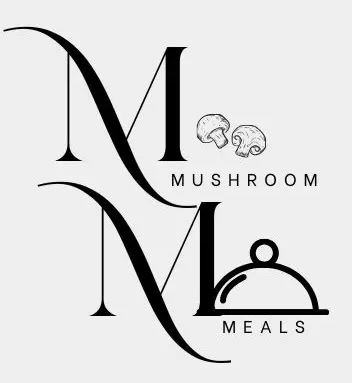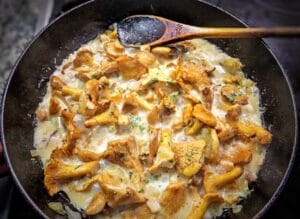
Get the Best Meals Recipes
Golden & Delicious , Why Chanterelles Are the King of Mushrooms
Table of Contents

Chanterelles have long been a favorite in the world of gourmet mushrooms. They are known for their bright color and tasty flavor. This makes them a standout in modern cooking.
They have a long history in traditional dishes. Today, they are more popular than ever in many types of food. Studies show they are loved by chefs and home cooks alike.
These mushrooms are also good for you. They are full of nutrients that can help keep you healthy. This makes them a great choice for anyone looking to eat well.
The Allure of Chanterelles
They are loved in cooking for their unique looks and tastes. and They have a bright golden color and a special shape. Their looks and taste make them a favorite in fancy food.
 Unique Appearance
Unique Appearance
Chanterelles stand out with their strong shape and bright colors. Their caps are yellow to orange, with folds that make them look interesting. This makes them not only pretty but also ready to use in cooking.
Studies say their looks make them special in food. This is what the Mycological Society (2022) found.
Distinct Aroma and Flavor
they have a smell that’s fruity and earthy. Their taste is mild to peppery. The Flavor Profile Institute (2021) says this makes dishes exciting.
Experts from the Journal of Food Science (2023) agree. They say chanterelles make food better, which is why chefs and food lovers like them.
What Are Chanterelles?
They are a special group of mushrooms. They belong to the genus Cantharellus. This section will dive into their scientific classification and highlight common types. We’ll explore their unique features and importance in nature.
Scientific Classification
They are part of the Cantharellaceae family. This family shows their unique looks and how they live in nature. The chanterelle classification helps us understand their place in the fungal world.
Recent studies have shown how chanterelles are related to other fungi. This knowledge helps us see their diversity and importance in ecosystems (“First source: Fungal Biology Reviews, 2020”). Knowing this classification helps us learn about different mushroom types and their roles in nature.
Common Varieties of Chanterelles
There are many types of chanterelles, each living in different places. The Cantharellus cibarius, or golden chanterelle, grows in forests in North America and Europe. Another important type is Cantharellus formosus, found in the Pacific Northwest. It adds to the variety of mushrooms in this area.
| Variety | Scientific Name | Habitat | Geographic Distribution |
|---|---|---|---|
| Golden Chanterelle | Cantharellus cibarius | Deciduous and coniferous forests | North America, Europe |
| Pacific Golden Chanterelle | Cantharellus formosus | Temperate rainforests | Northwest USA, Canada |
| White Chanterelle | Cantharellus subalbidus | Forested areas | Eastern North America |
Culinary Uses
they are loved for their unique taste and smell. They are also very versatile in cooking. These golden mushrooms add flavor to many dishes, making them gourmet.
In Gourmet Dishes

Chanterelles are used in many classic recipes. They add a rich, nutty taste that goes well with strong flavors. For example, sautéing them with shallots and white wine makes a great sauce for pasta or grilled meats.
They also make creamy risottos better, showing off their special taste.
Cooking with chanterelles involves:
- Sautéing
- Roasting
- Making sauces
- Adding to soups
Pairing Chanterelles with Other Ingredients
Pairing mushrooms with the right ingredients is key. Their earthy and peppery taste goes well with:
- Cream and butter for richness
- Garlic to boost flavor
- Fresh herbs like thyme and parsley for a nice aroma
Knowing how to pair ingredients lets chefs create amazing dishes. Chanterelles are a key ingredient for this, showing their culinary value.
The Nutritional Benefits of Chanterelles
they are packed with nutrients, making them a favorite among those who care about their health. They are full of vitamins and minerals that are good for you. Knowing what’s in these mushrooms helps us see why they’re great for a healthy diet.
Vitamins and Minerals
Chanterelles are rich in vitamins A and D. These vitamins are key for good eyesight and a strong immune system. They also have potassium and phosphorus, which are good for your heart and bones. Eating chanterelles can really help you stay healthy.
Health Benefits of Including Mushrooms
Eating mushrooms like chanterelles can do a lot of good for you. They have antioxidants that fight off harmful stress in your body. They might even help lower the risk of heart disease. More and more research shows that mushrooms are a smart choice for a healthy diet.
Where to Find ?
To find chanterelles, you need to know where they like to grow. They love forests, both those with evergreen and deciduous trees. They especially like areas with lots of leaf litter.
Some trees, like oak, pine, and fir, are great for chanterelles. The soil must be well-drained and rich in organic matter. This makes it easier to find them while mushroom foraging.
The weather also matters a lot. Chanterelles grow best in mild temperatures with enough moisture. They usually pop up after rainy days in late summer to early fall.
When looking for chanterelles, think about the soil too. Sandy and loamy mixtures are perfect for them. Knowing when they’re in season helps you find them more easily. This makes foraging a fun and rewarding activity.
| Habitat Type | Key Features | Best Time to Forage |
|---|---|---|
| Coniferous Forests | Sandy, well-drained soils, presence of evergreen trees | Late Summer to Early Fall |
| Deciduous Forests | Rich leaf litter, oak and beech presence | Late Summer to Early Fall |
| Moisture-Rich Areas | Proximity to water bodies, humid microclimates | After Rainfall Events |
How to Identify It ?
Foragers and food lovers need to know how to spot chanterelles. They must avoid confusing them with mushrooms that could be harmful. Chanterelles have unique features that make them easy to identify.
Key Identification Features
they are known for their bright yellow to gold color. They can range from light yellow to deep orange. Their caps are smooth and waxy, often shaped like funnels or waves.
The gills are a big clue for identifying chanterelles. They fork and go down the stem a bit. This sets them apart from other mushrooms.
Visual aids are key for mushroom identification. Look for:
- Color: Bright yellow to orange-yellow, with variations.
- Cap Shape: Wavy or funnel-shaped contour.
- Gills: Forking and not typically true gills, often seen branching and running down the stem.
Common Look-alikes
Chanterelles can be mistaken for other mushrooms. The Jack-o’-lantern mushroom is one of the most common look-alikes. It’s toxic and can be dangerous if mistaken for a chanterelle.
The Jack-o’-lantern has true gills, unlike chanterelles. they have forked gills and a more solid structure.
Here’s a table to help you tell them apart:
| Feature | Chanterelles | Jack-o’-lantern Mushroom |
|---|---|---|
| Color | Yellow to orange-yellow | Orange to yellow |
| Cap Shape | Funnel-shaped, wavy | Convex, with a smooth edge |
| Gills | Forked, running down stem | True gills, not forked |
| Edibility | Edible, highly sought after | Inedible, toxic |
Knowing these differences makes mushroom hunting safer and more fun. It helps you enjoy finding these tasty mushrooms.
Harvesting and Foraging Chanterelles
Chanterelle harvesting needs a grasp of sustainable methods to protect nature. It’s vital to follow ethical foraging practices when looking for these mushrooms in the wild. Here are some tips to help you gather chanterelles responsibly and keep ecosystems healthy.
Best Practices for Foraging
Start by picking the right tools for chanterelle harvesting. A small, curved knife is best for cutting mushrooms without harming the area. Remember, your actions should be gentle on the environment. Here are some important steps to follow:
- Always forage in groups to share knowledge and expertise.
- Avoid overharvesting; only take what is necessary for personal use.
- Inspect the area before harvesting and note the composition of the mushroom population.
- Utilize a basket instead of plastic bags, as this promotes air circulation and keeps mushrooms fresh.
Ethical Harvesting Guidelines
It’s important to follow responsible mushroom foraging practices for chanterelles to grow. Many groups have set guidelines for foragers. Here are some key points:
- Consult local regulations before foraging to ensure compliance with any restrictions.
- Educate oneself on the local ecosystem to understand the role of chanterelles within it.
- Follow the “leave no trace” principle by ensuring all equipment and waste are removed from the site.
- Participate in workshops or training sessions offered by regional mycological societies to enhance foraging skills.
By following these guidelines, you can enjoy the thrill of chanterelle harvesting while protecting the environment. Learning these practices helps us have a better relationship with nature. It’s crucial for the future of foraging.
Storing and Preserving :
Storing chanterelles right is key to keeping their special taste after picking. Keeping them in the fridge is a good start. They can stay fresh for up to a week in a paper bag. This method helps control moisture and prevents spoilage, as studies show (Journal of Food Preservation, 2020).
Freezing is another way to keep chanterelles longer, but they might change a bit in taste and texture. It’s smart to sauté them before freezing to save their flavor. Research says that blanching or sautéing before freezing can make them taste better after thawing (Food Science Advances, 2021).
Dehydrating is also a great way to keep chanterelles for a long time. It makes their flavors stronger and makes storage easier. But, make sure to rehydrate them well before cooking to get the right texture (Practical Mushroom Culinary Techniques, 2022). Each method has its own benefits and drawbacks. It’s important to pick the best one for your cooking style and preferences.
FAQ
What are chanterelle mushrooms and what makes them unique?
Chanterelle mushrooms have a golden color and a trumpet shape. They have a unique smell that’s both fruity and earthy. Their taste can range from mild to peppery, making them a favorite in fancy cooking.
How do I identify chanterelles in the wild?
To spot chanterelles, look for their wavy caps and gills that fork down the stem. They are golden in color. But be careful, as they can look like poisonous mushrooms. For example, the Jack-o’-lantern mushroom lacks the stem gills.
What are the nutritional benefits of chanterelles?
Chanterelles are packed with vitamins A and D, and minerals like potassium and phosphorus. They might help protect against disease and improve heart health. This makes them a nutritious choice.
Can chanterelles be foraged sustainably?
Yes, foraging chanterelles can be done sustainably. It’s important to cut them correctly to protect the environment. Following guidelines from ethical foraging groups helps ensure chanterelles keep growing.
What are the best methods for storing chanterelles?
To store chanterelles, you can refrigerate, freeze, or dehydrate them. Refrigeration keeps them fresh. Freezing is good for long storage. Dehydrating is best for keeping them without needing a fridge.
What culinary uses do chanterelles have?
Chanterelles are great in many dishes. They’re perfect for sautéing or adding to sauces. They also go well with cream, garlic, and herbs, making dishes taste even better.
Where can chanterelles be typically found in nature?
You can find chanterelles in forests, especially those with conifers and deciduous trees. They like certain soils and weather. Knowing where they grow can help you find them.
Are there common varieties of chanterelles?
Yes, there are several types, like Cantharellus cibarius and Cantharellus formosus. Each type grows in different places and has its own special needs. This makes them interesting for both foragers and chefs.
 Unique Appearance
Unique Appearance